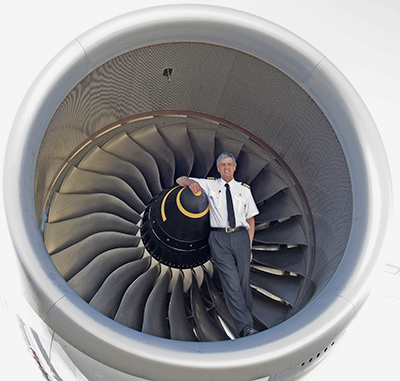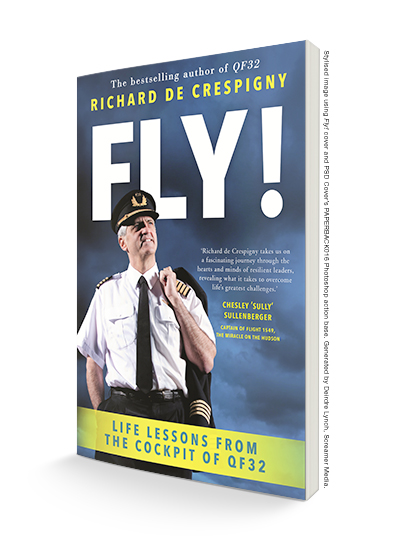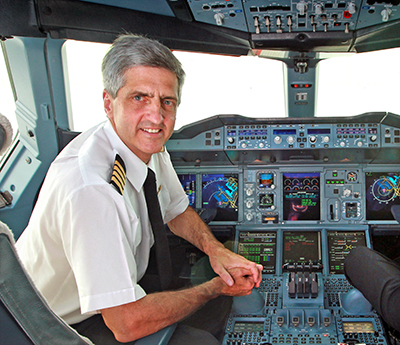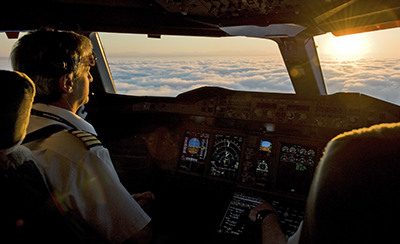How techniques used in averting an aviation disaster relate to your business life
When Qantas A380 pilot Richard De Crespigny was confronted with a life-and-death inflight explosion, soon after take-off from Singapore, he had to call upon all of his flying and aviation systems experience in order to land safely. However, the real ace up his sleeve turned out to be his passion for – and what he calls Deliberate Practice of – a people management method he refers to as High Reliability Organisation leadership. He learned it from the best in the business – people like flight director for NASA’s $104 billion Apollo program, Gene Kranz – and now De Crespigny has literally written the book on the life lessons he learned from the cockpit of QF32 on that fateful day.
By Mike Sullivan >>
THE SAME techniques that a highly trained – and determined – Qantas team used to avert what could easily have become one of the world’s worst aviation disasters, can be used to save you, your loved ones and your business life.
The events and responses that kept the 469 people aboard Qantas flight 32 alive, over Singapore on November 4, 2010, may not immediately seem related to business leadership and resilience. But they are. And Richard De Crespigny is very adept at explaining how much they are.
Here’s how precarious the situation was: After the unprecedented inflight explosion of one of its four Rolls Royce Trent 900 engines, QF32 had shrapnel and fire damage that disabled 21 of the Airbus A380’s 22 systems. Two explosions had severed 650 wires and network cables. Under 50 percent of the airliner’s electrics and hydraulics were operational. Jet fuel and hydraulic fluids were leaking from the badly damaged left wing. Key pumping systems to move fuel around the aircraft’s 11 tanks, to help stabilise the aircraft in flight, were non-operational. 
After working out how to keep the aircraft safely in the air, QF32’s crew were shocked in their careful testing to discover that the A380’s 21-wheel undercarriage could only be lowered using a gravity-forced option – and it also became worrisomely clear the aircraft’s remaining three engines were not operating normally.
Fortunately, as fate would have it – for all aboard whose lives were at stake and for their fearful families – QF32, on that fine November day, had misfortune equally counterbalanced by good fortune.
That luck started with the line-up of QF32’s skilled, experienced and innovative crew – which by chance included two extra ‘check captains’ who were assessing both Richard De Crespigny and the trainee ‘check captain’. It meant there were five minds and thousands more hours of experience to throw at the life-critical problems that ensued.
It also meant greater pressure on the lines of communication and leadership: decisions had to be made fast. All reporting, actions and ideas had to be imparted clearly and without the impositions of ego and rank.
A FATEFUL INTEREST
This is where Richard De Crespigny’s unique pedigree really came into play in 2010. Well before this fateful flight, he had developed a deep interest in human performance, resilience and leadership under stress – and he was a devoted student of aviation incidents and accidents.
That special interest had been heightened through his early flying years as a jet fighter pilot with the Royal Australian Air Force (RAAF) – and developed even as a youth from hearing stories and opinions expressed by this father, Peter De Crespigny, a former professional pilot who is still qualified to fly today at age 92.
In fact, when Richard spoke to his friend Neil Armstrong – yes, that Neil Armstrong, the late astronaut, test pilot and aero-engineer – about his father’s exercise regime of swimming 3000m every week to ensure he maintained his private pilot’s licence, Armstrong said: “Give Peter my congratulations. He’s my inspiration!”
Crucially, if Richard De Crespigny had not used his leadership knowledge and easy-going natural style to set up the team atmosphere and problem-solving environment in the cockpit before this flight, a potential overload of experience on the flight deck may have actually contributed to the risk.
One of the check captains, Dave Evans, remarked to De Crespigny later, “It would be hard to find a more A380-experienced crew on the planet …”
But in the author’s research for the book Fly!, an international aviation safety investigator told him that “with so many pilots in the cockpit during the QF32 incident, it was remarkable” that they did not crash.
“He subsequently sent me an analysis of aircraft emergencies where the crew was augmented by extra pilots,” De Crespigny wrote. “Far from an additional pilot making the situation safer, it made it more likely to end in disaster. This might seem counter-intuitive, but the explanation is simple.
“For some flights with augmented crews, the cockpit turns into a committee. Blurring the chain of command allows for distraction, confusion, indecision, arguments and bad outcomes. The investigator was astonished that his had not happened to us.
“In turn, I was surprised that he did not identify a failure to define every team member’s role as an explanation for his findings, followed by the conclusion that some pilots needed training to become better leaders.
“In the case of QF32, I confirmed before the flight, then later enforced, the command structure of our augmented crew, thus preventing confusion when things went wrong.”
All this was part of De Crespigny’s focus on team dynamics and leadership, in which he engages before every flight, fitting in briefings over coffee with his flight deck and attending cabin crew briefings.
Well before the afflicted QF32 incident, De Crespigny had focussed his professional interest on finding ways to help teams perform better through stressful situations and realised that, in his industry, flight safety predominantly came down to leadership styles and methods.
There was a particular discussion among the pilots before that fateful QF32 flight about roles and responsibilities, including De Crespigny working a compromise about operational positions.
“The check captain offered a compromise: if required, he would act as Second Officer. I was happy with this and we took off with all five pilots having a clear, and shared, view of their roles, tasks and responsibilities. This was to prove all-important when the engine exploded.” 
DOWN TO BUSINESS
Here is where the author’s rationalisations can be applied to other areas of life, especially business – and most readers will run parallel evaluations of their own business life situations as they read parts of this book.
The QF32 pre-flight cockpit scenario could be similarly played out in a boardroom situation, say, of a company facing a potentially business-ending crisis.
For example, a company which has geared up its activities and borrowed capital to meet certain customer requirements can be quickly derailed when there is a sudden financial downturn in that industry – or a series of failures of their major clients, such as what occurred in Australia during and the Global Financial Crisis (GFC) onset in 2007 and for many years following.
Sitting in the ‘business cockpit’ might be the business’s leadership team – one or two of whom know they have not been achieving the desired results – the company accountant, a business specialist brought in to help recover the situation (and drawing money out of the business fast) and representatives of finance companies. Bankers may be urging the company to go into administration before they push the button on that option (for they are the first to be paid) and the landlord may be threatening to lock the doors for unpaid rent. Equipment financiers may be threatening to repossess equipment the company needs to work its way out of trouble. The ATO could also be making legal and bank account garnishee warnings.
Staff are wary and concerned and some are making demands, while rumours are rife, causing distress to their families as well. They have bills and mortgages to pay. The business owner is prioritising staff payments over all else, but this is making the ATO and creditor situation worse by the week.
The business leader has to step up and reason with all parties to build a consensus that buys the business time to resolve its plight for all concerned. The ideal outcome is for the business to continue and for everyone to be paid what they are due over time. It requires the business leaders to find a way to reason with all concerned, find common ground, buy time to deliver on promises and encourage compassion from those around the table while acknowledging all their self-interests.
And there are also the existential issues of what is happening to the business brand and the professional reputations of those on the leadership team.
You might reasonably argue that a life-threatening aviation situation is conducted at levels of stress well beyond the world of business – but is it? The human challenges are similar although time frames are not.
While an aviation emergency unfolds over a short period of time, often over a few hours and occasionally over just a few minutes, a business-threatening crisis often evolves over years. Years of building stress. Years of testing the resilience of leaders.
When a business Black Swan event happens, it is not just about having the leadership skills and team focus to deal with it – leaders often have to question whether they still possess the energy to see the situation through. Leaders also have to be realistic about whether financial and other resources can be gathered and whether the goodwill of staff, clients and suppliers will be forthcoming and sufficient.
The suicide statistics of business leaders who have been beaten by crises and their businesses and family wealth destroyed – enduring an insidious kind of slow-burn post-traumatic stress – cannot be overlooked.
The situations are different, but the impacts both physical and mental can be similar.
THE SCIENCE
Richard De Crespigny was a student of leadership, and the psychology and physiology involved in successful leadership, well before the 2010 QF32 emergency. If anything, he has become an even more avid researcher since that day and he brings his collection of knowledge and learnings to the fore in Fly!: Life Lessons from the Cockpit of QF32.
In fact, throughout the book he explains how his learnings from the challenges of that flight and others have eventually provided many positives for both his business and family life.
De Crespigny is something of a scholar on coping with stress. He draws on other people’s experiences and thoughts ranging from ancient scholars and resilient figures of history, to test pilots and astronauts, to university professors, psychologists and neuro-scientists.
He presents many sensitive and sensible snapshots of wisdom from business greats such as Warren Buffett, Bill Gates, Elon Musk, Richard Branson, Australia’s Dick Smith and others.
THE PARALLELS
The parallels with business are clear. In Australia at the moment, those officially considering what has gone wrong with the banking and insurance industries would do well to consider a list like the one below, compiled by the author (p169).
De Crespigny was largely talking about the kinds of poor leaders he had encountered in the aviation industry and in cockpits over many years when he identified the classic signs that he noticed of poor leaders. He wrote, they:
- “are driven and dominated by ego, power and control, using abuse, threats, intimidation and coercion
- “hoard information as a source of power
- “talk before they listen and think
- “close their doors (metaphorically and literally) and selectively filter feedback
- “cannot settle on decisions
- “lack empathy
- “don’t trust, so micro-manage others and undermine confidence
- “don’t support whistleblowers and people who step up
- “never admit they have failed
- “take the credit for wins and find excuses or blame others for errors and losses.”
The author relates crisis and emergency leadership directly to business leadership, among many of the interviews he conducted.
“My cousin Robert Champion de Crespigny AC is a successful entrepreneur who created a mining empire, served as a university chancellor, an advisor to governments and a member on many not-for-profit, industry and educational boards. He says, ‘Success sometimes breeds cancerous ego and greed. Even good leaders can eventually fall prey to believing their own bulldust. If you look at successful businesses led by very good chief executives, who clearly are great leaders, ego, hubris and conceit nearly always creep in before a fall. They increasingly forget to credit the teams that enabled their success. This is when the rot creeps in. A cook is only as good as his last meal. Generally, when the ego takes over that’s when they drop the ball and fall.’”
With such knowledge and experience building, Richard De Crespigny made a vital declaration for his own career. 
“I was determined that when I became a captain I would be as different as possible from the bad leaders I had seen. I knew that teams, never autocratic leaders, built resilient organisations. History proves that leaders who ignore their teams eventually fail. Survival depends on amassing the knowledge, experience and skills from many people into an intelligent and responsive team that learns, creates and adapts.
“It was clear to me that a leader does not just determine the culture, the leader IS the culture! The leader’s behaviour sets the tone for every activity their team undertakes, not just those that need direction and management. I was determined to set the best culture for my crews and passengers on every flight. So I looked around me for role models and exemplary leaders and studied them closely.”
Richard De Crespigny started finding leaders to admire from his own industry and ended up with an extraordinary list that included many famous names who eventually became his friends, including first-man-on-the-moon Neil Armstrong and co-pilot Buzz Aldrin; NASA flight director Gene Kranz who led the mission control teams supporting the Apollo missions; Chesley ‘Sully’ Sullenberger who landed the stricken Flight 1549 twinjet on the Hudson River, New York; the first man to break the sound barrier, Chuck Yeager; and Australia’s own modern helicopter record breaker and business entrepreneur, Dick Smith.
LEADERSHIP STYLES
De Crespigny describes in detail the many leadership styles he has studied. He is clear about his own leadership style – one that worked so well throughout the most critical moments of QF32 and the extensive and exhausting days and months of follow-up with passengers, crew, investigators and the broader aviation industry – and he calls it High Reliability Organisation (HRO) leadership.
“Examples of successful HRO leadership include Gene Kranz, the Flight Director for NASA’s $104 billion Apollo program, and Ann Pickard, who has headed some of the Shell Oil Company’s most difficult and contentious operations including Arctic Ocean exploration.
“HRO leaders are mindful people who are knowledgeable, well trained and experienced. They possess the fierce will to enforce safety. They resist the urge to apply simplistic solutions to complex situations. They understand their systems down to their core components, using these skills to implement novel and creative solutions. HRO leaders trust (but verify) and defer to expertise. They give single-minded advice to their teams – if you are not committed to the company’s culture, values and standards, then leave.
“Gene Kranz gave an insight into this mindset, describing the critical moment at which the decision had to be made to launch or abort: ‘There was no room in the process for emotion, no place for fear or doubt, no time to stop and think things over … You had to be prepared for any contingency, and those contingencies had to be as fully anticipated as possible before you pushed the button.’
“He added that a vital feature of HRO leadership is that leaders unhesitatingly assign critical tasks to someone capable of handling them and then, crucially, trust that person’s judgement rather than overriding it.”
De Crespigny has a very clear view of his own leadership style, having deeply researched many successful leaders and their methods.
“My recipe for HRO leadership includes responsibility, authority, risk, confidence, courage, initiative, care and communication. It requires the leaders to tame their ego and recognise their own vulnerabilities. HRO leaders know there are never enough learning experiences for them to ‘know it all’. Their humility to admit their own weaknesses is a vital step and strength in building a strong and resilient team where each member is capable, valued and respected.
“HRO leadership is hard work and not for the faint-hearted. You must be tough, fierce-willed, competent and courageous. You must also be humble. Communicate your values to your team and protect them, because these are the people that build resilience.”
AVIATE, NAVIGATE, COMMUNICATE
Richard De Crespigny proves the value of applying the lessons learned in the cockpit of QF32 to other areas of life – particularly business – through a broad range of scenarios over and over again.
“We’re all going to experience a crisis of some form, at some point. For airline pilots or nuclear power plant safety managers, a crisis might be a catastrophic equipment failure that puts hundreds of lives at risk. For communities, it might be natural disasters that devastate thousands. For corporations, it might be crippling financial loss or reputational damage. For families, it might be a frightening medical diagnosis, a job loss or a car crash.
“Here are the strategies I learned over 40-plus years of flying which helped me and everyone else aboard QF32 walk away safely:
- stay alive (‘Aviate, Navigate, Communicate’)
- create time
- accept your reality
- mitigate threats
- assess your options
- reassess priorities
- don’t rush
- think for yourself and resist stampedes
- forget perfection
- try inverting the logic
- communicate
- remember, there’s no such thing as an ‘unimaginable’ crisis.
Aviate, Navigate, Communicate is the pilot’s mantra to prioritise the initial actions in a crisis. It is all about staying alive … and the reality is that Navigate and Communicate can only come into play once a safe state of ‘aviation’ has been achieved.
The same mantra is a hugely useful metaphor to stabilising a business in mortal crisis.
Whether you find yourself saving lives or simply making your business ‘fly’, Richard De Crespigny’s entertaining and thoughtful book certainly has the Right Stuff. 
Quotes:
“Individuals, corporations, governments and every other entity you can think of must adapt, embrace the future and surf the edge of chaos, otherwise they will perish.” – Richard De Crespigny.
“To have the situation awareness to confront the immediate and very difficult reality, with a full and accurate appreciation of the risks, thereby making the decisions and taking the actions that directly lead to your survival.” Cresley ‘Sully’ Sullenberger, who glided his airliner to a safe landing on the Hudson River.
“When the winds of ill blow, don’t build walls, build imagination, creativity and windmills.” – Richard De Crespigny.
ends

 How to resolve AdBlock issue?
How to resolve AdBlock issue?